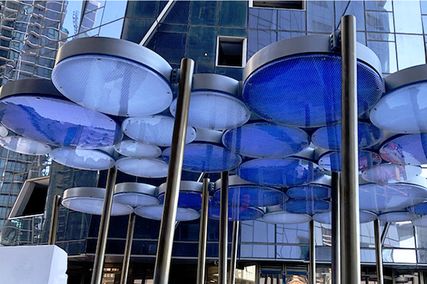Halfway Down the Stairs (extract)
Halfway up the stairs
Isn’t up,
And isn’t down.
It isn’t in the nursery,
It isn’t in the town.
And all sorts of funny thoughts
Run round my head.
It isn’t really
Anywhere!
It’s somewhere else
Instead!
—A. A. Milne1
When considering stairs, we have a tendency to focus on the object properties of this most necessary of architectural devices. We are drawn to the skeletal delicacy of Eva Jiricna’s steel and glass confections, Harry Seidler’s muscular spirals or Michaelangelo’s lava-like flow in the vestibule of the Laurentian Library.
However, we can also consider stairs not just as exquisite objects or twisting lines that connect different levels, but as highly specific places of poetic potential. In A. A. Milne’s short poem “Halfway Down the Stairs,” Christopher Robin finds himself in a place where he is momentarily free of the limitations of here or there, because he can be somewhere else instead; somewhere, anywhere, undefined and full of possibility. We begin to conceive of stairs not as a thing, but as a unique ontological event where, for a short time, we are physically and mentally elsewhere – a condition that the sociologist Erving Goffman referred to as being “away.”
On stairs we can be completely immersed in a multi-sensory experience that simultaneously combines all aspects of both here and there. For example, there is an escalator2 at Melbourne Central station that connects the ticketing concourse directly with lower platforms three and four. The journey takes a standing time of approximately forty seconds where, for the most part, we are contained within a concrete cylinder, our thoughts free to wander elsewhere before we arrive at our destination above or below. That is, except for one brief moment when platforms one and two bisect the stair-tube and there is a sudden, horizontal expansion of contained space. We instantaneously feel wind, noise and light and then just as suddenly we contract once more to the quiet, inner containment of the escalator that we never actually left. We have been passive participants; observers into another world without ever really being there.
Over the past twenty years, demand has grown for architects and designers to produce performative environments that engage directly with complex social needs. By their nature, such environments need to be flexible and indeterminate, and stairs are perfect for this purpose. As an event, they share similar performative qualities with the corridor in that both can be places for serendipitous, unstructured encounters. On stairs alone, however, we are temporarily suspended in time and space – between the moments of departure and arrival – where signals from the surrounding environments can be suppressed, providing a respite in the stream of a particular setting. As designers, we can exploit all these qualities for the purpose of unplanned activity and interaction: the conversation we have been meaning to have or the idea I have wanted to run past you but for which I have not been able to find the time. The value of these transactions is in their brevity and we can encourage such encounters through a thickening of space, just enough to pull out of the flow, but not so much as to predetermine the nature of the transaction.
A capacity for the simultaneous occupation of multiple spaces, the time to drift away and the opportunities presented for chance encounters all combine within this one powerful device. If we are not in our office/surgery/classroom/meeting room, we are free of the cognitive focus and state of mind required by the predetermined activities of those predefined places. Being somewhere else, we are momentarily free of both internal and external limitations and are therefore open to the possibilities of the unforeseen.
1. “Halfway Down the Stairs,” extract, from A. A. Milne, When We Were Very Young (Methuen & Co: 1924).
2. Defined as moving stairs.
Source

Discussion
Published online: 18 Jun 2012
Words:
Darragh O'Brien
Images:
Flickr: Epicture
Issue
Artichoke, March 2012
















